SCULPTURE Steven Siegel ART Starn Twins ROBERT SMITHSON global warming GARBAGE Matthew Barney Black Mountain College BURGESS SHALE Marlborough Chelsea STEPHEN JAY GOULD Penland School BLACK MOUNTAIN COLLEGE Barbara Gladstone Twin Peaks Landfill PACIFIC GARBAGE VORTEX

What makes Steven Siegel’s site-specific newspaper sculptures so special? What is so wonderful about his series of wall sculptures called “Wonderful Life”? And — now — what is the extra ingredient in Biography (at Marlborough Chelsea to Feb. 26) that allows me to claim we have a major sculptor on our hands?
Portfolio:

 .
.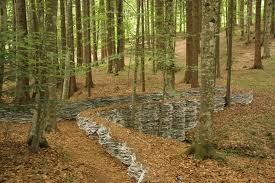
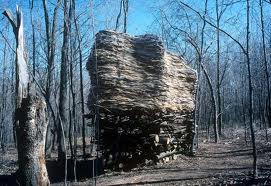
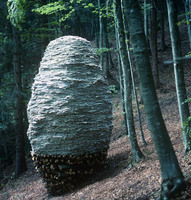
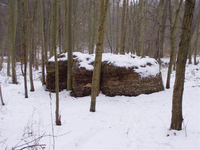
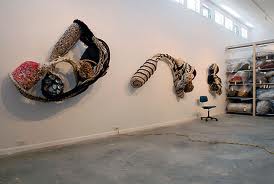
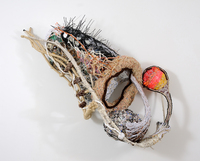
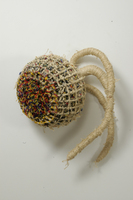
Siegel has been showing his sculptures for at least 30 years. But most of his work, until just this moment, has only been seen outside New York City
.
This may be because his work has usually been site-specific. But if truth be known, there is still a silence here — in galleries and the magazines — about art that is in the boondocks. Maybe an image here and there or an excellent interview in Sculpture Magazine — which, let’s face it, is not seen by all that many power-brokers or theorists, curators or collectors. Mike + Doug Starn can get a lot of attention for their photogenic but middling effort last summer on the roof of the Metropolitan Museum of Art — a shaky, gimcrack lookout made of lashed-together bamboo — whereas a sculptor as innovative as Patrick Dougherty, who for years has used the snagging of locally harvested saplings to make his “nests” and “lookouts” all over America, is unjustly neglected. Proximity is all. Proximity to power; proximity to media. Proximity is hegemony.
And so it seems that the reign of bad painting is not yet over. Painting is so portable, affordable, so automatically photogenic and so…easy to ship. And store. I love paintings.
Sculpture, by which I mean the actually physical mode of three-dimensional artmaking, is too cumbersome, bothersome, and troublesome. Takes up room; takes time. I love sculpture. And everything in between.
But sculpture, in fact, has lost out to painting since the rebirth of same in the gruesome ’80s. Or was it the ’90s? Painting was reborn, or so goes the legend, in Germany or somewhere in an art department in Upstate New York or perhaps California. Actually, in hindsight this was the death of painting, but no one was watching. They were too busy investing.
And why was sculpture lost? Unless it is super-cumbersome and super-troublesome like the work of Richard Serra — who brilliantly seems to have cornered that particular market — sculpture is not worth its weight in gold. It is not yet traded like stocks and bonds. Sculpture likes to stay put. We are not talking about the trinkets people once placed on their mantels or end-tables. We are talking about the big stuff.
Otherwise, sculpture is either Pop or not. We love Koons’ Puppy, and Hirst is not the worst. But is this sculpture?
Well, we had better make some room for Steven Siegel and whatever else will be coming down the line.
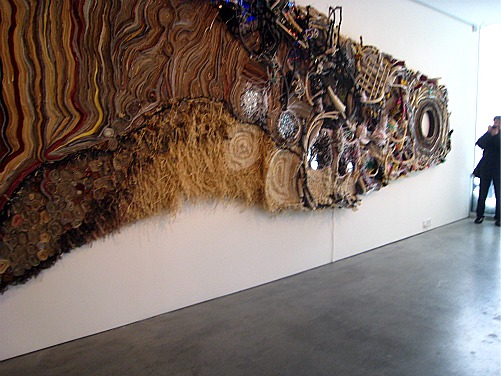
You May No Longer Go to the Head of the Class
Why has it taken so long for Siegel to gain visibility? The scouting system broke down and/or too much art is being produced for the system to function. No one knows how to sort or cull. Or — and this is the killer thought — beginning with dealer Barbara Gladstone’s 1990 discovery of ex-Ralph Lauren model, ex-jock Matthew Barney when he was just two years out of Yale, it was thought to be easier to raid the art schools than actually scout for fresh blood in the hinterlands. Critics had long since given up scouting; they were content, like curators, to let the dealers do all the work. Hence the beginning of what is now called Art School Art: new, cheap, and no legs.
Then it got even worse. Collectors became the art scouts. Some were able to do a better job of it, believe it or not, than the professionals. And although this phrase is of questionable grammar, they put their money where their mouth is.
Now, at last, Art School Art is over. Collectors are only now coming out of hiding. And some dealers, I am told, will not even look at any artist who has an MFA from Yale or a grant from the Warhol Foundation or a Guggenheim. All too academic. The students now have students and aptly illustrate the law of infinite regress. Maturity might be the new norm. Playing catchup is the new game in museums and elsewhere. Endurance counts.
Portfolio (North Carolina):
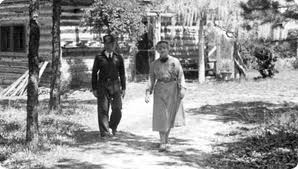
Jacques and Juliana Busbee, founders of Jugtown, c. 1922
Traditional ground hog kiln:
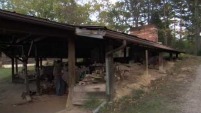
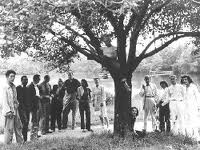
Black Mountain College faculty, c. 1951. Josef and Anni Albers, at extreme left.

Penland School, Penland, N.C. (founded 1923)
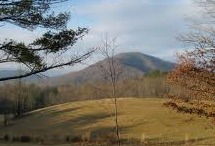
View from Penland School porch. Where are the llamas?
The Boon at Boone
In 2009, I wrote a catalog essay for an exhibition of Steven Siegel’s art at the Turchin Center for the Visual Arts, Appalachian State University, Boone, North Carolina. North Carolina and I go way back. I once toured the Tar Heel State for its arts council and made a lot of discoveries for myself, not the least of which was the cluster of traditional farmer-potters in the Piedmont, where immigrated Brits with such family names as Cole, Craven, Owen(s), and Teague have been turning and burning their lovely wares for generations. Resuscitated by patrons and confirmed do-gooders Jacques and Juliana Busbee in 1922, already using drippy salt-glaze like the ancient Koreans, the Jugtown potters added some decidedly Asian forms to their lead-glazed and tobacco-spit jugs and dishes.
When I made my tour, Black Mountain College had long ago bit the dust. That was where — students provided by the G.I. Bill — Josef and Anni Albers, John Cage, Robert Creeley, Merce Cunningham, Willem de Kooning, Richard Lippold, M.C. Richards, Theodoros Stamos, and Jack Tworkov once taught. This is where Merce met Bob (Rauschenberg) and where the latter first made his all-white paintings.
Instead, I visited Penland School beyond Thomas Wolfe’s Asheville — now quite charming — and deeper into the Blue Ridge Mountains. Penland School was founded in 1923 by Miss Lucy Morgan — another do-gooder. Always called Miss Lucy, her goal was to save the mountain weaving tradition then threatened. Penland has since became a summer crafts school open to all and offering workshops in all craft media — a school with llamas on the hill across the road, believe it or not. Llamas, the animals, not lamas. But there may have been some “hidden” lamas lurking about. Undercover as it were, I later took a pottery class there.
Boone was also one of my stops.
Years later, my Siegel essay came about because I juried an outdoor-sculpture show for Boone’s wooded campus and it was clear that Siegel was the first-prize winner with his site-specific, outdoor newspaper pieces, Squeeze II.
When his solo exhibition in Boone, N.C., (not, I remind you, at Mary Boone in N.Y.) was slated, I was asked by the director of the Turchin Center to write a catalog essay. I previewed the new work at Siegel’s studio in Red Hook, Dutchess County, New York.
When I saw the new work I was nonplussed.
It took me awhile to adjust. The exhibition was going to consist of 52 wall pieces inspired by Stephen Jay Gould’s exposition, in his book Wonderful Life, of the discoveries of the Burgess Shale and what they might portend.
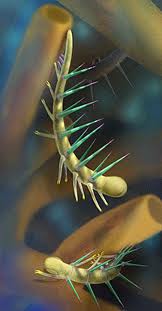
Hallucigenia from the Burgess Shale. (Mary Parriish}
The shale high up in the Canadian Rockies near Banff (and then other sites in China, Greenland, Siberia, Australia and the U.S. from the same time) presents a biological puzzle. Why was there, way before the age of the dinosaurs and even before the horseshoe crab, this remarkable proliferation of life forms? More life forms than now exist, many of them gone, but astounding in their variety? We are talking about unexpected, previously unknown phyla, not species. More phyla then those now extant. Does Creationism rear its head? Darwinian evolution punctured by a biological explosion caused by sudden climate change? A comet, continental shift, a tilt of the earth’s axis?
I looked. I pondered. I got it.
Siegel, in his use of countless materials to generate, via the Burgess idea, a proliferation of forms, was using variety as opposed to uniformity, inventiveness as opposed to reason. He was not illustrating the Burgess Shale idea but identifying with it.
The closest artist I can think of is Robert Smithson. We are talking about Time, about ideas in art that go beyond quoting texts and putting them up on a wall, about subject matter and form fully integrated. Smithson was nourished by geological time and by Gondwana, the ancient super-continent in the Southern Hemisphere that finally broke apart to become South America, Australia, Africa.
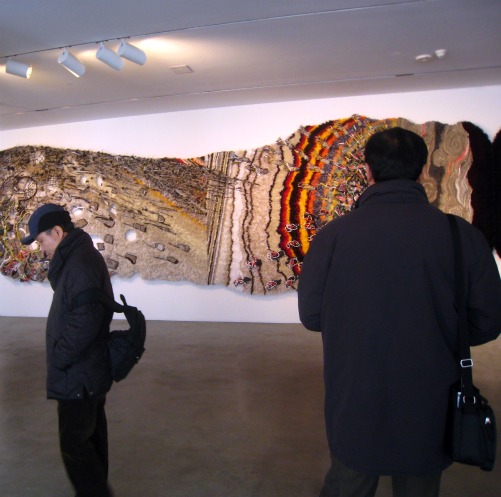
Now Biography, Siegel’s new 75-foot wallpiece, tackles not only trash and time (like his outdoor sculptures), but time in a different way. The outdoor site-specific, layered-newspaper pieces reference time through dated newsprint layered like geological strata, and because of their ultimate disintegration. The layers become soggy, moldy. They sink, they rot. Nature is back on top.
In Biography, the time is a time of its own making; studio time, moving from the snake’s “head” backwards to the left. The work has not been seen in its entirety before. It is too big even for Siegel’s studio. The photo he sent to various galleries — which, in fact, was what got him the current show at Marlborough — was a composite. Unsolicited photo wins sculptor blue chip gallery! If you read it first in Walter Robinson’s Artnet, you may have thought this was a joke. But I confirmed it with the artist. It’s true.
In the second-floor gallery of Marlborough, Biography takes up two walls across one corner. Ropes, wires, Christmas-tree lights and what have you. The quotidian. The kind of stuff you just throw out without thinking about it. Trash transformed.
Kurt Schwitters pioneered the use of effluvia in art and was then followed decades later by Robert Rauschenberg. Perhaps we now have a Schwitters and a Rauschenberg specifically for our time. We certainly need one.
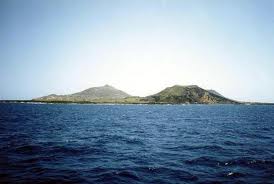
Garbage In” Is Not Always “Garbage Out”
From my point of view, the use of trash as an art material is another attack on what I call the art-supply- industry hoax that keeps the unwary and the ever-hopeful pre-artist frantically stocking up on expensive paints and linen canvases. And I am all for further destabilizing the idea that art must be made of certain sacrosanct materials.
But a concerted effort to use garbage instead of bronze or marble to make sculpture will not solve, alas, our garbage problem, as symbolized by the Texas-sized Pacific Vortex of floating plastic circling somewhere between Seattle and Hawaii. There is an Atlantic Vortex too, somewhere between Argentina and South Africa. I hope I do not have to remind you of this again.
Nor will the garbage-into-art initiative — which is mine, not Siegel’s — demolish the double-breasted garbage dump that looms over Sunrise Highway on Long Island, the one dubbed “Twin Peaks” by droll Suffolk County locals. This so-called landfill is rumored to be the highest point (or highest two points) on Long Island. Photos show that from the Twin Peaks you can indeed see Long Island Sound to the north and the Great South Bay to the south. I hasten to add that two big breasts of garbage is not quite the proper way to honor Mother Nature.
Given the latest Global Warming surprise — New York City switching places weatherwise with Buffalo — Twin Peaks might double as ski slopes or downhill- racing venues. Snow as high as a Buffalo’s eye, in Suffolk County? Had you ever before heard of the Arctic Fence, now breached, or the Arctic Vortex? What will they think of next.
I have better hopes for the Artopian idea to use garbage to form new barrier reefs against the rising tide that will otherwise flood so much expensive shoreline property.
Full fathoms five thy father lies;
Of his bones are coral made;
Those are pearls that were his eyes;
Nothing of him that doth fade,
But doth suffer a sea-change
Into something rich and strange.Sea-nymphs hourly ring his knell:
Ding-dong.
Hark! now I hear them — Ding-dong, bell.
Ariel’s Song,” The Tempest, by William Shakespeare
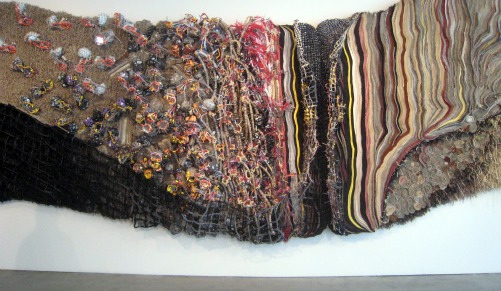
We Now Want Smart Art and Smart Artists
That said, it should be noted — and noted rather strenuously — that there is a lot more going on in Siegel’s art than just layers and knots of stuff. Surely there is irony and ecology, but there is also brains. And a gift for the aesthetic. In art, one is not any good without the other.
I understand that playing dumb can be fun and sometimes smart — smart as in “fashionable,” and even smart as “intelligent.” The hedgehog outlasts the fox. Intelligence is threatening. But had Conceptual Art gone too far? I say it never went far enough. In any case, boredom with language and such was no excuse to turn off the lights on thought, leaving bad painting to rule.
Dumb deep down is just dumb. There are many kinds of intelligence. Not everyone has to be a verbal whiz-kid; not everyone has to know Greek rhetoric or calculus. Great dancers and athletes have kinetic intelligence. There is even emotional intelligence. The heart can be wise. But the dumbing down of art has gone far enough.
My heart bleeds for you, when you complain that a certain artwork makes you think. So what else should it do? I vote for making you get up and dance; I vote for making you weep; but I do not vote for confirming mental conformity.
Siegel’s art is about transformation, and an alchemical one at that. Biography is breathtaking. This is an artwork that has presence; the elevator door opens and you are in a new world. We have suffered long enough from Dumb Art or Tweedledum-and-Tweedledee Art. Siegel turns everyday waste into sculpture, foregrounding transformation as revelation. Beauty, therefore, can be released from even newspapers and Christmas tree lights. It’s a great day for art.

NEVER MISS AN ARTOPIA ESSAY AGAIN!
FOR AN AUTOMATIC ARTOPIA ALERT E-MAIL perreault@aol.com
John Perreault is on Facebook.
You can also follow John Perreault on Twitter: johnperreault
Preview: THE, A Novel by John Perreault.
